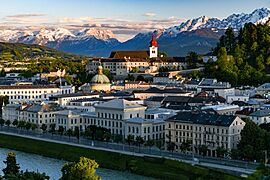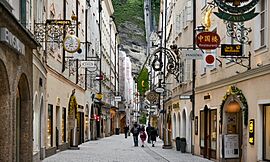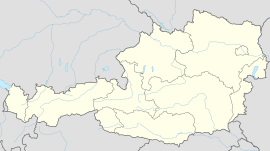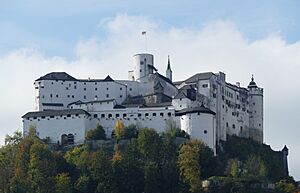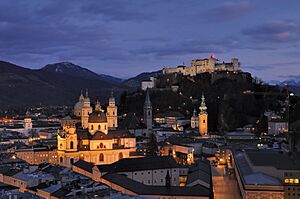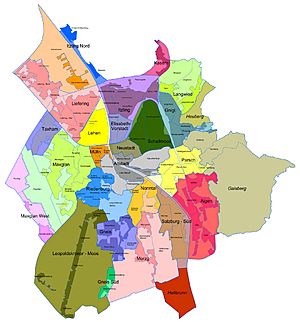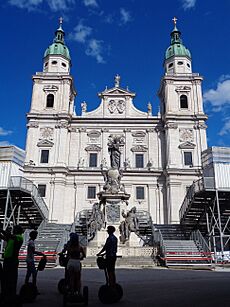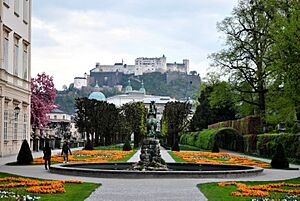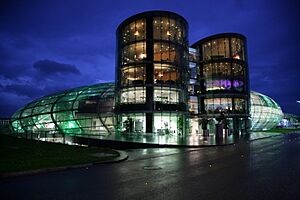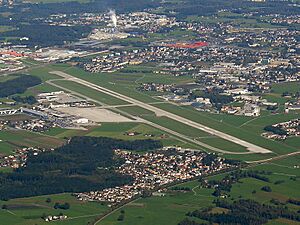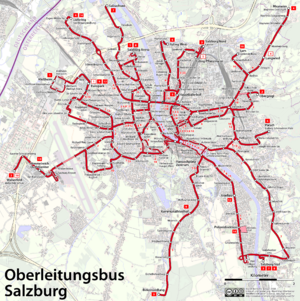Salzburg facts for kids
Quick facts for kids
Salzburg
|
|||
|---|---|---|---|
|
Top to bottom, left to right: view of University of Salzburg in front of the Salzach, with Nonnberg Abbey in the background; Hohensalzburg Fortress; Salzburg Cathedral; Roittner-Durchhaus; and Getreidegasse
|
|||
|
|||
| Country | |||
| Federal state | Salzburg | ||
| District | Statutory city | ||
| Elevation | 424 m (1,391 ft) | ||
| Population
(1 October 2020)
|
|||
| • Total | 157,245 | ||
| Demonym(s) | English: Salzburger or Salzburgian German: Salzburger (m.), Salzburgerin (f.) |
||
| Time zone | UTC+1 (CET) | ||
| • Summer (DST) | UTC+2 (CEST) | ||
| Postal code |
5020
|
||
| Area code | 0662 | ||
| Vehicle registration | S | ||
| UNESCO World Heritage Site | |
|---|---|
 |
|
| Criteria | Cultural: ii, iv, vi |
| Inscription | 1996 (20th Session) |
| Area | 236 ha |
| Buffer zone | 467 ha |
Salzburg is the fourth-largest city in Austria. In 2020, about 157,000 people lived there.
The city is built where a Roman settlement called Iuvavum once stood. Salzburg was founded as a bishopric in 696. It became the home of an archbishop in 798. The city earned money from mining salt and gold, and from trade. The Hohensalzburg Fortress, one of Europe's largest medieval castles, was built in the 11th century. In the 1600s, Salzburg became a center for the Counter-Reformation, leading to many monasteries and beautiful Baroque churches being built.
Salzburg's historic center (called Altstadt) is famous for its Baroque architecture. It is one of the best-preserved old city centers north of the Alps. Because of its beauty and history, the historic center became a UNESCO World Heritage Site in 1996. Salzburg also has three universities and many students.
Contents
- Understanding the Name "Salzburg"
- Exploring Salzburg's Past
- Geography and Location
- People and Population
- City Architecture and Design
- City Districts
- Top Places to Visit
- Education and Learning
- Famous People from Salzburg
- Events and Festivals
- Getting Around Salzburg
- Language Spoken in Salzburg
- Sports in Salzburg
- International Connections
- Images for kids
- See Also
Understanding the Name "Salzburg"
The name "Salzburg" was first written down in the late 700s. It means "Salt-Castle."
- Salz-: This part comes from the German word for "salt."
- -burg: This part comes from an old West Germanic word meaning "fortified settlement" or "city." It is not like the modern German word "Burg," which means "fortress."
The name comes from the boats that carried salt on the Salzach River. These boats had to pay a fee in the 8th century, which was common for many towns on European rivers.
Exploring Salzburg's Past
Ancient Times to the Middle Ages
People have lived in the Salzburg area since the Neolithic Age (New Stone Age). During the La Tène period, it was an important center for the Celts.
After the Romans arrived in 15 BC, they built a new city called Municipium Claudium Juvavum in the old town area. This city became very important in the Roman province of Noricum.
When the Roman province fell apart in 488, some of the Roman-Celtic people stayed. In the 6th century, they came under the rule of the Baiuvarii. Around 696, Saint Rupert helped the city grow again. He received the Roman town's remains and a castle on the Nonnberg Terrace from Duke Theodo II of Bavaria. In return, Rupert was to spread Christianity in Bavaria.
Rupert chose Juvavum for his church. He built a church at St. Peter and likely founded the monastery there. He also started a nunnery on Nonnberg for his relative Erentrude. Salzburg has been a bishop's seat since 739 and an archbishopric since 798. The first cathedral was built under Archbishop Virgil.
The Hohensalzburg Fortress, the city's main castle, was built in 1077 by Archbishop Gebhard. He made it his home, and it was made much larger over the next centuries.
The state of Salzburg grew powerful because of its salt mining and missionary work. In 996, Otto III, Holy Roman Emperor gave Archbishop Hartwig the right to hold markets and mint coins. The city began to spread out, and the first city walls were built around 1280.
Gaining Independence
Salzburg became independent from Bavaria in the late 1300s. It was the seat of the Archbishopric of Salzburg, a prince-bishopric within the Holy Roman Empire.
During the German Peasants' War, farmers revolted, and the city was taken over. The Archbishop had to hide in the fortress, which was under attack for three months in 1525.
After these troubles, Salzburg became very wealthy and successful. This was especially true from the late 1500s to the 1700s under Prince Archbishops Wolf Dietrich von Raitenau, Markus Sittikus, and Paris Lodron. During the 17th century, Italian architects helped rebuild the city center in the beautiful Baroque style we see today. Many palaces were also built.
Modern Times
Religious Changes
On October 31, 1731, Archbishop Count Leopold Anton von Firmian signed an order called the Emigrationspatent. This order told all Protestant citizens to give up their non-Catholic beliefs. About 21,475 citizens refused and were forced to leave Salzburg. Most of them moved to East Prussia, while others settled in different parts of Europe and America.
The Age of Enlightenment
From 1772 to 1803, under Archbishop Hieronymus von Colloredo, Salzburg was a center for the Illuminism. Colloredo was one of the main people who hired Wolfgang Amadeus Mozart. Colloredo and Mozart often disagreed, and Colloredo eventually told Mozart to leave. Mozart moved to Vienna in 1781.
Changes in Rule
In 1803, Emperor Napoleon took control of the archbishopric. He gave the land to Ferdinando III of Tuscany, who became the Elector of Salzburg.
In 1805, Salzburg became part of the Austrian Empire. In 1809, it was given to the Kingdom of Bavaria. After the Congress of Vienna in 1816, Salzburg was finally returned to Austria. However, some parts of its land stayed with Bavaria.
In 1850, Salzburg became the capital of the Duchy of Salzburg, a special region of the Austrian Empire. It became part of Austria-Hungary in 1866. As people became interested in history and old times, tourism grew. In 1892, a funicular (a type of cable railway) was built to help tourists visit Hohensalzburg Fortress.
The 20th Century
First Austrian Republic
After World War I and the end of the Austro-Hungarian Empire, Salzburg became part of the new German Austria. In 1919, this became the First Austrian Republic.
Joining Nazi Germany
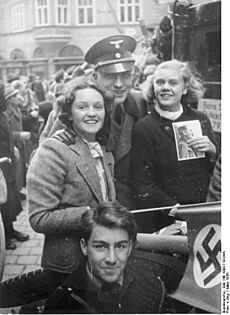
On March 12, 1938, Nazi Germany took over Austria, including Salzburg. German troops entered the city. People who disagreed with the Nazis, Jewish citizens, and other groups were arrested and sent to camps. The local synagogue was destroyed.
World War II
During World War II, several camps for prisoners of war were set up in Salzburg. A camp for Romani was also built, where they were forced to work. This camp also held Romani people before they were sent to other camps. Salzburg was also the site of five smaller camps connected to the Dachau concentration camp.
Allied bombings destroyed many houses and killed 550 people. About 46 percent of the city's buildings were damaged, especially near the railway station. However, much of Salzburg's beautiful Baroque architecture remained. This makes Salzburg one of the few cities of its style that is still largely intact. American troops entered the city on May 5, 1945. Salzburg became the center of the American-controlled area in Austria. Many camps for people who had lost their homes were set up in Salzburg.
Salzburg Today
After World War II, Salzburg became the capital of the Federal State of Salzburg. American forces left after Austria signed a treaty in 1955, making the country democratic and independent. Austria then declared itself neutral.
In the 1960s, the famous musical film The Sound of Music was filmed and set in Salzburg. On January 27, 2006, all 35 churches in Salzburg rang their bells to celebrate the 250th birthday of Wolfgang Amadeus Mozart.
In 2017, Salzburg had a high GDP per person (€46,100), which was more than the average for Austria and most European countries.
Geography and Location
Salzburg is located on the banks of the Salzach River, at the northern edge of the Alps. The mountains to the south are very different from the flat plains to the north. The closest mountain peak, the 1,972-meter-high Untersberg, is less than 16 kilometers from the city center.
The Altstadt, or "old town," is known for its baroque towers and churches. The large Hohensalzburg Fortress also stands out. Two smaller hills, the Mönchsberg and Kapuzinerberg, provide green spaces within the city. Salzburg is about 150 kilometers east of Munich and 300 kilometers west of Vienna.
Because it is so close to the Austrian-German border, the Salzburg area sometimes includes parts of Germany. Public transport lines even cross the border.
Salzburg's Climate
Salzburg has a humid continental climate. This means it has four distinct seasons with noticeable temperature changes. Because it's at the northern edge of the Alps, Salzburg gets a lot of rain, especially in summer. The local people call a specific light rain Schnürlregen. In winter and spring, strong warm winds called foehn winds often occur.
| Climate data for Salzburg-Flughafen (LOWS) 1991–2020, extremes 1874–present | |||||||||||||
|---|---|---|---|---|---|---|---|---|---|---|---|---|---|
| Month | Jan | Feb | Mar | Apr | May | Jun | Jul | Aug | Sep | Oct | Nov | Dec | Year |
| Record high °C (°F) | 20.8 (69.4) |
21.7 (71.1) |
24.9 (76.8) |
30.3 (86.5) |
34.1 (93.4) |
35.7 (96.3) |
37.7 (99.9) |
36.6 (97.9) |
33.3 (91.9) |
28.2 (82.8) |
24.1 (75.4) |
19.1 (66.4) |
37.7 (99.9) |
| Mean daily maximum °C (°F) | 3.4 (38.1) |
6.2 (43.2) |
10.2 (50.4) |
15.7 (60.3) |
19.3 (66.7) |
23.2 (73.8) |
24.3 (75.7) |
24.0 (75.2) |
19.9 (67.8) |
14.4 (57.9) |
8.5 (47.3) |
4.0 (39.2) |
14.4 (57.9) |
| Daily mean °C (°F) | 0.0 (32.0) |
1.6 (34.9) |
5.7 (42.3) |
10.1 (50.2) |
14.4 (57.9) |
17.9 (64.2) |
19.6 (67.3) |
19.4 (66.9) |
15.0 (59.0) |
10.4 (50.7) |
4.8 (40.6) |
0.9 (33.6) |
10.0 (50.0) |
| Mean daily minimum °C (°F) | −3.6 (25.5) |
−2.8 (27.0) |
0.7 (33.3) |
4.3 (39.7) |
8.3 (46.9) |
12.5 (54.5) |
13.8 (56.8) |
13.6 (56.5) |
10.1 (50.2) |
5.6 (42.1) |
0.9 (33.6) |
−2.5 (27.5) |
5.1 (41.2) |
| Record low °C (°F) | −30.4 (−22.7) |
−30.6 (−23.1) |
−21.6 (−6.9) |
−9.2 (15.4) |
−3.4 (25.9) |
−0.1 (31.8) |
3.7 (38.7) |
2.0 (35.6) |
−3.0 (26.6) |
−8.3 (17.1) |
−18.0 (−0.4) |
−27.7 (−17.9) |
−30.6 (−23.1) |
| Average precipitation mm (inches) | 59 (2.3) |
53 (2.1) |
87 (3.4) |
78 (3.1) |
115 (4.5) |
151 (5.9) |
158 (6.2) |
164 (6.5) |
112 (4.4) |
73 (2.9) |
72 (2.8) |
72 (2.8) |
1,195 (47.0) |
| Average snowfall cm (inches) | 20.0 (7.9) |
19.5 (7.7) |
11.5 (4.5) |
1.4 (0.6) |
0.0 (0.0) |
0.0 (0.0) |
0.0 (0.0) |
0.0 (0.0) |
0.0 (0.0) |
0.6 (0.2) |
6.5 (2.6) |
18.8 (7.4) |
78.3 (30.8) |
| Average snowy days (≥ 1.0 cm) | 14.6 | 12.2 | 5.6 | 0.8 | 0.0 | 0.0 | 0.0 | 0.0 | 0.0 | 0.2 | 3.8 | 10.0 | 47.2 |
| Average relative humidity (%) (at 14:00) | 71.7 | 63.5 | 56.1 | 50.5 | 53.0 | 54.6 | 53.2 | 55.0 | 59.3 | 62.9 | 71.1 | 73.9 | 60.4 |
| Mean monthly sunshine hours | 67.0 | 91.9 | 130.0 | 152.6 | 196.4 | 193.9 | 221.1 | 202.8 | 167.7 | 129.7 | 81.2 | 62.8 | 1,697.1 |
| Percent possible sunshine | 26.9 | 34.4 | 37.9 | 39.4 | 44.3 | 43.7 | 48.8 | 48.3 | 47.4 | 42.9 | 30.8 | 26.7 | 39.3 |
| Source 1: Central Institute for Meteorology and Geodynamics (precipitation 1981–2010, sun 1971–2000) | |||||||||||||
| Source 2: Meteo Climat (record highs and lows) | |||||||||||||
| Climate data for Salzburg-Flughafen (LOWS) 1961–1990 | |||||||||||||
|---|---|---|---|---|---|---|---|---|---|---|---|---|---|
| Month | Jan | Feb | Mar | Apr | May | Jun | Jul | Aug | Sep | Oct | Nov | Dec | Year |
| Mean maximum °C (°F) | 10.5 (50.9) |
13.2 (55.8) |
19.6 (67.3) |
23.2 (73.8) |
26.8 (80.2) |
30.1 (86.2) |
31.4 (88.5) |
31.3 (88.3) |
27.9 (82.2) |
23.4 (74.1) |
18.0 (64.4) |
11.5 (52.7) |
31.4 (88.5) |
| Mean daily maximum °C (°F) | 2.4 (36.3) |
4.9 (40.8) |
9.5 (49.1) |
14.1 (57.4) |
18.9 (66.0) |
21.8 (71.2) |
23.8 (74.8) |
23.4 (74.1) |
20.1 (68.2) |
15.1 (59.2) |
8.0 (46.4) |
3.2 (37.8) |
13.8 (56.8) |
| Daily mean °C (°F) | −1.3 (29.7) |
0.7 (33.3) |
4.7 (40.5) |
8.9 (48.0) |
13.3 (55.9) |
16.4 (61.5) |
18.3 (64.9) |
18.0 (64.4) |
15.0 (59.0) |
10.0 (50.0) |
4.2 (39.6) |
−0.3 (31.5) |
9.0 (48.2) |
| Mean daily minimum °C (°F) | −5.0 (23.0) |
−3.4 (25.9) |
−0.1 (31.8) |
3.7 (38.7) |
7.7 (45.9) |
11.1 (52.0) |
12.9 (55.2) |
12.7 (54.9) |
9.9 (49.8) |
5.0 (41.0) |
0.4 (32.7) |
−3.7 (25.3) |
4.3 (39.7) |
| Mean minimum °C (°F) | −15.1 (4.8) |
−11.9 (10.6) |
−7.5 (18.5) |
−1.9 (28.6) |
1.5 (34.7) |
5.3 (41.5) |
7.8 (46.0) |
7.1 (44.8) |
3.8 (38.8) |
−1.6 (29.1) |
−7.5 (18.5) |
−14.0 (6.8) |
−15.1 (4.8) |
| Average precipitation mm (inches) | 63.4 (2.50) |
59.1 (2.33) |
66.1 (2.60) |
82.9 (3.26) |
128.6 (5.06) |
154.3 (6.07) |
160.0 (6.30) |
152.8 (6.02) |
89.9 (3.54) |
68.0 (2.68) |
73.9 (2.91) |
71.4 (2.81) |
1,170.4 (46.08) |
| Average precipitation days (≥ 1.0 mm) | 10.7 | 10 | 11.1 | 12.3 | 13.3 | 15.1 | 14.5 | 13.8 | 10 | 8.6 | 10.2 | 11.6 | 141.2 |
| Average relative humidity (%) | 82 | 79 | 74 | 70 | 69 | 71 | 71 | 75 | 78 | 80 | 81 | 82 | 76 |
| Average afternoon relative humidity (%) | 74 | 67 | 58 | 54 | 53 | 56 | 55 | 57 | 60 | 63 | 70 | 76 | 62 |
| Average dew point °C (°F) | −3.7 (25.3) |
−2.9 (26.8) |
−0.6 (30.9) |
2.8 (37.0) |
7.2 (45.0) |
10.6 (51.1) |
12.5 (54.5) |
12.7 (54.9) |
10.5 (50.9) |
6.0 (42.8) |
0.7 (33.3) |
−2.7 (27.1) |
4.4 (40.0) |
| Mean monthly sunshine hours | 68.2 | 90.4 | 130.2 | 153 | 189.1 | 201 | 223.2 | 201.5 | 174 | 139.5 | 78 | 62 | 1,710.1 |
| Mean daily sunshine hours | 2.2 | 3.2 | 4.2 | 5.1 | 6.1 | 6.7 | 7.2 | 6.5 | 5.8 | 4.5 | 2.6 | 2 | 4.7 |
| Source 1: Deutscher Wetterdienst | |||||||||||||
| Source 2: NOAA(mean monthly max/min-Dew Point) | |||||||||||||
People and Population
Population Growth Over Time
| Historical population | ||
|---|---|---|
| Year | Pop. | ±% |
| 1869 | 27,858 | — |
| 1880 | 33,241 | +19.3% |
| 1890 | 38,081 | +14.6% |
| 1900 | 48,945 | +28.5% |
| 1910 | 56,423 | +15.3% |
| 1923 | 60,026 | +6.4% |
| 1934 | 69,447 | +15.7% |
| 1939 | 77,170 | +11.1% |
| 1951 | 102,927 | +33.4% |
| 1961 | 108,114 | +5.0% |
| 1971 | 129,919 | +20.2% |
| 1981 | 139,426 | +7.3% |
| 1991 | 143,978 | +3.3% |
| 2001 | 142,662 | −0.9% |
| 2011 | 145,270 | +1.8% |
| 2021 | 154,604 | +6.4% |
| Source: Statistik Austria | ||
Salzburg's population grew a lot in 1935 when nearby towns became part of the city. After World War II, many people who had lost their homes found new ones in Salzburg. Around 1950, Salzburg reached 100,000 citizens. By 2016, it had over 150,000 citizens.
Diverse Communities
Salzburg is home to many different groups of people. Large communities from Germany, Bosnia, Serbia, and Romania live here.
Here are the largest groups of people from other countries living in Salzburg as of January 1, 2021:
| 7,816 | |
| 5,189 | |
| 4,805 | |
| 2,914 | |
| 2,521 | |
| 2,457 | |
| 1,947 | |
| 1,686 | |
| 1,595 | |
| 1,197 |
City Architecture and Design
Romanesque and Gothic Styles
For a long time, the medieval city was shaped by Romanesque and Gothic churches, monasteries, and early stone houses. The Cathedral built by Archbishop Conrad of Wittelsbach was the largest church north of the Alps. The choir of the Franciscan Church is a famous Gothic religious building in southern Germany. Later Gothic buildings include Nonnberg Abbey and parts of Hohensalzburg Fortress.
Renaissance and Baroque Styles
Prince-Archbishop Wolf Dietrich von Raitenau started to change the medieval town. He wanted it to look like the grand buildings of the late Renaissance. A new cathedral, designed by Santino Solari, became the first early Baroque church in Salzburg. It inspired many other churches in Southern Germany and Austria.
Later, leaders like Markus Sittikus and Paris von Lodron continued to rebuild the city. They added important places like Hellbrunn Palace, the archbishop's home, university buildings, and strong defenses. Italian and Austrian architects helped create the beautiful Baroque city center we see today.
Modern and Contemporary Buildings
Salzburg also has buildings from the modern era and after World War II. Examples include the "Lepi" public baths (built in 1964) and the original congress center (built in 1957). A very important modern building is the Großes Festspielhaus, an opera house opened in 1960.
Adding contemporary architecture to Salzburg's old town is tricky because of its UNESCO World Heritage status. However, some new buildings have been added, like parts of the Mozarteum and the "Makartsteg" bridge. Outside the old town, you can find the blob-shaped Hangar-7 at Salzburg Airport and the Europark Shopping Centre.
City Districts
Salzburg has 24 city districts and three areas outside the main city.
- Urban districts (Stadtteile):
- Aigen
- Altstadt
- Elisabeth-Vorstadt
- Gneis
- Gneis-Süd
- Gnigl
- Itzling
- Itzling-Nord
- Kasern
- Langwied
- Lehen
- Leopoldskron-Moos
- Liefering
- Maxglan
- Maxglan-West
- Morzg
- Mülln
- Neustadt
- Nonntal
- Parsch
- Riedenburg
- Salzburg-Süd
- Taxham
- Schallmoos
- Extra-urban populations (Landschaftsräume):
- Gaisberg
- Hellbrunn
- Heuberg
Top Places to Visit
Salzburg is a very popular place for tourists. During busy times, there are more visitors than local residents! Besides Mozart's birthplace, here are some other famous sights:
- In the Old Town:
- Historic center of the city of Salzburg: A World Heritage Site recognized for its beauty.
- Baroque architecture: Many beautiful churches and buildings from the Baroque period.
- Felsenreitschule: An open-air theater built in a quarry.
- Franziskanerkirche: One of Salzburg's oldest buildings, from 1208.
- Getreidegasse: A busy shopping street with tall, old houses.
- Großes Festspielhaus: A large opera and concert hall built in 1960 for the Salzburg Festival.
- Haus für Mozart: Another opera and concert hall, built in 1925.
- Hohensalzburg Fortress (Festung Hohensalzburg): A huge castle overlooking the Old Town, one of Europe's largest.
- Holy Trinity Church (Dreifaltigkeitskirche): Built in 1694.
- Hotel Goldener Hirsch: A historic five-star hotel on Getreidegasse.
- Kollegienkirche: The Baroque style church of the University of Salzburg.
- Mirabell Palace (Schloss Mirabell): A beautiful palace from 1606 with large gardens and a marble hall.
- Museum der Moderne Salzburg: A modern art museum.
- Mozartplatz: A historic square with a statue of Wolfgang Amadeus Mozart.
- Mozart's birthplace (Mozarts Geburtshaus): The house where Mozart was born, now a museum.
- Nonnberg Abbey (Stift Nonnberg): A Benedictine monastery founded around 712-715.
- Residenz: The former home of the Prince-Archbishops.
- Residenzgalerie: An art museum inside the Residenz.
- Residenzplatz: A large square outside the Residenz with a big, fancy fountain.
- Salzburg Cathedral (Salzburger Dom).
- Salzburger Landestheater: A theater for opera, plays, and dance.
- Salzburger Marionettentheater: A puppet theater started in 1912.
- Salzburg Museum: A museum about the city's art and history.
- Sigmundstor: An 18th-century tunnel connecting the Old Town through the Mönchsberg hill.
- Sphaera: A sculpture of a man on a golden sphere.
- St Peter's Abbey (Stift Sankt Peter): A Benedictine monastery founded in 696, with a famous cemetery.
- St Sebastian's Church (Sebastianskirche): A church built in 1511.
- Outside the Old Town:
- Schloss Leopoldskron: A beautiful Rococo palace in a southern district of Salzburg.
- Hellbrunn: Known for its parks and palaces.
- The Sound of Music tours: Companies offer tours to film locations from the movie.
- Hangar-7: A building owned by Red Bull, with a collection of historic airplanes, helicopters, and Formula One cars.
- Haslachmühle: A historic flour mill.
- Greater Salzburg Area:
- Anif Castle: Located south of the city.
- Shrine of Our Lady of Maria Plain: A Baroque church north of Salzburg.
- Salzburger Freilichtmuseum Großgmain: An open-air museum with old farmhouses.
- Schloss Klessheim: A palace and casino.
- Untersberg mountain: Next to the city, offering great views of Salzburg and the Alps.
- Skiing: Salzburg is a good starting point for skiing areas to the south in winter.
- Salzburg Zoo: Located south of the city.
Education and Learning
Salzburg is an important center for education. It has three universities, several professional colleges, and high schools (called gymnasiums).
Universities and Colleges
- University of Salzburg: A public university.
- Paracelsus Medical University.
- Mozarteum University Salzburg: A public university for music and dramatic arts.
- Fachhochschule Salzburg.
- Alma Mater Europaea: A private university.
- SEAD Salzburg Experimental Academy of Dance.
Famous People from Salzburg
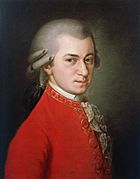


- Heinrich Biber (ca 1644-1704): A violinist and composer who worked in Salzburg.
- Joseph Leutgeb (1732–1811): A talented horn player at the archbishop's court.
- Johann Michael Haydn (1737–1806): A composer and younger brother of Joseph Haydn. He taught Carl Maria von Weber and Anton Diabelli.
- Wolfgang Amadeus Mozart (1756–1791): The famous composer was born and grew up in Salzburg. He worked as a musician for the archbishop. His birthplace and home are popular tourist spots.
- Joseph Mohr (1792–1848): A Catholic priest and writer born in Salzburg. He wrote the words to the song "Silent Night".
- Christian Doppler (1803–1853): A scientist born in Salzburg who discovered the Doppler effect, which explains how sound and light waves change.
- King Otto of Greece (1815–1867): Born at Mirabell Palace just before Salzburg returned to Austrian rule.
- Hans Makart (1840–1884): An important Austrian painter. A square in Salzburg is named after him.
- Theodor Herzl (1860–1904): An Austro-Hungarian Jewish journalist who helped start modern political Zionism. He worked in Salzburg after getting his law degree.
- Georg Trakl (1887–1914): An important German poet born in Salzburg.
- Georg von Trapp (1880–1947) and Maria von Trapp (1905–1987): Their family, the Trapp Family, lived in Salzburg until they moved to the United States.
- Stefan Zweig (1881–1942): A writer who lived in Salzburg for about 15 years.
- Herbert von Karajan (1908–1989): A famous orchestra conductor born in Salzburg.
- Thomas Bernhard (1931–1989): A novelist, playwright, and poet who grew up in Salzburg.
- Roland Ratzenberger (1960–1994): A Formula One racing driver born in Salzburg.
- Felix Baumgartner (born 1967): A skydiver and BASE jumper who set three world records.
Events and Festivals
- The Salzburg Festival is a very famous music and theater festival. It brings many visitors in July and August each year. A smaller Salzburg Easter Festival happens around Easter.
- The Europrix multimedia award takes place in Salzburg.
- The Electric Love Festival is also held in Salzburg.
Getting Around Salzburg
Train Travel
Salzburg Hauptbahnhof (the main train station) has many train connections. Fast trains often go east to Vienna, west to Munich, Innsbruck, and Zürich. There are also trains that go north and south to places like Venice and Prague. Salzburg is a key stop for trains traveling through the Alps into Italy.
Air Travel
Salzburg Airport has regular flights to European cities like Frankfurt, Vienna, London, and Zürich. Many charter flights also come to Salzburg.
Local Transport
Within the city, there is a trolleybus and bus system with over 20 lines. Buses run every 10 minutes. Salzburg also has an S-Bahn (suburban train) system with four lines. These trains leave the main station every 30 minutes. One line, the S1, goes to the famous Silent Night chapel in Oberndorf in about 25 minutes.
Language Spoken in Salzburg
Austrian German is the main written language. It is very similar to German spoken in Germany, with only a few differences in words and grammar. In Salzburg, people often speak Austro-Bavarian dialects, especially Central Bavarian. Both young and old people speak it. However, some experts have noticed that fewer school children in the city are speaking the dialect. They think this might be because kids spend more time with media that uses standard German.
Sports in Salzburg
Football (Soccer)
The former SV Austria Salzburg team reached the UEFA Cup final in 1994. On April 6, 2005, Red Bull bought the club and changed its name to FC Red Bull Salzburg. The team's home stadium is the Wals Siezenheim Stadium, which was used for the 2008 European Football Championship. FC Red Bull Salzburg plays in the top Austrian league, the Austrian Bundesliga.
After Red Bull changed the club's name and colors, some fans started a new club called SV Austria Salzburg. They wanted to keep the old name and traditions. This new club was founded in 2005. It has played in the second-highest league in Austria. Since 2019, it plays in the third tier, the Regionalliga Salzburg.
Ice Hockey
Red Bull also supports the local ice hockey team, the EC Salzburg Red Bulls. This team plays in a league that includes top teams from Austria, Hungary, Slovenia, Croatia, Italy, and one Czech team.
Other Sports
Salzburg tried to host the 2010 Winter Olympics and 2014 Winter Olympics, but it was not chosen.
International Connections
Sister Cities
Salzburg has "twin towns" or "sister cities" around the world. This means they have special friendly relationships.
- Reims, France (since 1964)
- Verona, Italy (since 1973)
- León, Nicaragua (since 1984)
- Singida, Tanzania (since 1984)
- Busseto, Italy (since 1988)
- Vilnius, Lithuania (since 1989)
- Dresden, Germany (since 1991)
- Supovsky, Russia (since 2016)
- Kawasaki, Japan (since 1992)
- Meran, Italy (since 2000)
- Shanghai, China (since 2004)
- Jahrom, Iran (since 2019)
- Leeds, England (since 2022)
Images for kids
-
Mozart monument
-
Fountain in the Residenzplatz
-
View of the old town and fortress, seen from Kapuzinerberg
See Also
 In Spanish: Salzburgo para niños
In Spanish: Salzburgo para niños


